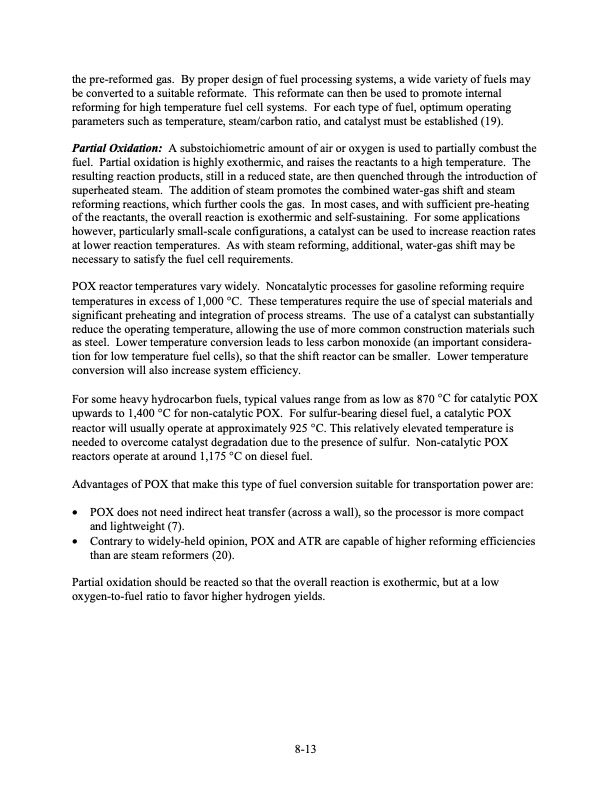
PDF Publication Title:
Text from PDF Page: 258
the pre-reformed gas. By proper design of fuel processing systems, a wide variety of fuels may be converted to a suitable reformate. This reformate can then be used to promote internal reforming for high temperature fuel cell systems. For each type of fuel, optimum operating parameters such as temperature, steam/carbon ratio, and catalyst must be established (19). Partial Oxidation: A substoichiometric amount of air or oxygen is used to partially combust the fuel. Partial oxidation is highly exothermic, and raises the reactants to a high temperature. The resulting reaction products, still in a reduced state, are then quenched through the introduction of superheated steam. The addition of steam promotes the combined water-gas shift and steam reforming reactions, which further cools the gas. In most cases, and with sufficient pre-heating of the reactants, the overall reaction is exothermic and self-sustaining. For some applications however, particularly small-scale configurations, a catalyst can be used to increase reaction rates at lower reaction temperatures. As with steam reforming, additional, water-gas shift may be necessary to satisfy the fuel cell requirements. POX reactor temperatures vary widely. Noncatalytic processes for gasoline reforming require temperatures in excess of 1,000 °C. These temperatures require the use of special materials and significant preheating and integration of process streams. The use of a catalyst can substantially reduce the operating temperature, allowing the use of more common construction materials such as steel. Lower temperature conversion leads to less carbon monoxide (an important considera- tion for low temperature fuel cells), so that the shift reactor can be smaller. Lower temperature conversion will also increase system efficiency. For some heavy hydrocarbon fuels, typical values range from as low as 870 °C for catalytic POX upwards to 1,400 °C for non-catalytic POX. For sulfur-bearing diesel fuel, a catalytic POX reactor will usually operate at approximately 925 °C. This relatively elevated temperature is needed to overcome catalyst degradation due to the presence of sulfur. Non-catalytic POX reactors operate at around 1,175 °C on diesel fuel. Advantages of POX that make this type of fuel conversion suitable for transportation power are: • POX does not need indirect heat transfer (across a wall), so the processor is more compact and lightweight (7). • Contrary to widely-held opinion, POX and ATR are capable of higher reforming efficiencies than are steam reformers (20). Partial oxidation should be reacted so that the overall reaction is exothermic, but at a low oxygen-to-fuel ratio to favor higher hydrogen yields. 8-13PDF Image | Fuel Cell Handbook (Seventh Edition)

PDF Search Title:
Fuel Cell Handbook (Seventh Edition)Original File Name Searched:
fuel-cell-handbook.pdfDIY PDF Search: Google It | Yahoo | Bing
NFT (Non Fungible Token): Buy our tech, design, development or system NFT and become part of our tech NFT network... More Info
IT XR Project Redstone NFT Available for Sale: NFT for high tech turbine design with one part 3D printed counter-rotating energy turbine. Be part of the future with this NFT. Can be bought and sold but only one design NFT exists. Royalties go to the developer (Infinity) to keep enhancing design and applications... More Info
Infinity Turbine IT XR Project Redstone Design: NFT for sale... NFT for high tech turbine design with one part 3D printed counter-rotating energy turbine. Includes all rights to this turbine design, including license for Fluid Handling Block I and II for the turbine assembly and housing. The NFT includes the blueprints (cad/cam), revenue streams, and all future development of the IT XR Project Redstone... More Info
Infinity Turbine ROT Radial Outflow Turbine 24 Design and Worldwide Rights: NFT for sale... NFT for the ROT 24 energy turbine. Be part of the future with this NFT. This design can be bought and sold but only one design NFT exists. You may manufacture the unit, or get the revenues from its sale from Infinity Turbine. Royalties go to the developer (Infinity) to keep enhancing design and applications... More Info
Infinity Supercritical CO2 10 Liter Extractor Design and Worldwide Rights: The Infinity Supercritical 10L CO2 extractor is for botanical oil extraction, which is rich in terpenes and can produce shelf ready full spectrum oil. With over 5 years of development, this industry leader mature extractor machine has been sold since 2015 and is part of many profitable businesses. The process can also be used for electrowinning, e-waste recycling, and lithium battery recycling, gold mining electronic wastes, precious metals. CO2 can also be used in a reverse fuel cell with nafion to make a gas-to-liquids fuel, such as methanol, ethanol and butanol or ethylene. Supercritical CO2 has also been used for treating nafion to make it more effective catalyst. This NFT is for the purchase of worldwide rights which includes the design. More Info
NFT (Non Fungible Token): Buy our tech, design, development or system NFT and become part of our tech NFT network... More Info
Infinity Turbine Products: Special for this month, any plans are $10,000 for complete Cad/Cam blueprints. License is for one build. Try before you buy a production license. May pay by Bitcoin or other Crypto. Products Page... More Info
| CONTACT TEL: 608-238-6001 Email: greg@infinityturbine.com | RSS | AMP |